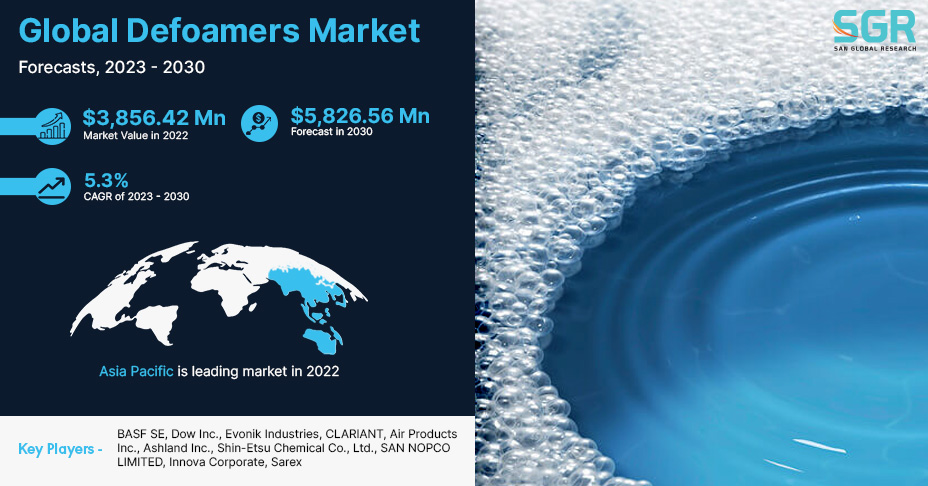The Future of Defoamers: Innovations and Trends in Foam Control Solutions
Selecting the Right Defoamer for Your Details Application Needs
Choosing the appropriate defoamer for certain application requirements is a nuanced procedure that demands careful consideration of numerous aspects, such as the foam operating, medium, and kind conditions. Recognizing the subtleties of defoamer efficiency-- consisting of rate and perseverance-- while likewise accounting for regulatory and environmental variables is essential.
Comprehending Foam Development
Foam formation takes place when gas is caught within a liquid, producing a secure structure of bubbles. This sensation can substantially affect various industrial processes, particularly in sectors such as food manufacturing, drugs, and wastewater therapy. The existence of foam can hinder blending, minimize item top quality, and even bring about functional ineffectiveness.
Foam normally develops due to a mix of variables, including surface-active agents, agitation, and the qualities of the liquid stage. Surfactants reduced the surface area stress of the liquid, promoting the formation of bubbles that can integrate and maintain. Frustration, whether from mechanical mixing or gas intro, improves bubble formation, bring about increased foam quantity.
Comprehending the auto mechanics of foam formation is crucial for markets intending to enhance their procedures. By determining the particular conditions that promote foam generation, companies can execute strategies to reduce its results.
Types of Defoamers Available
Numerous sorts of defoamers are offered to resolve the challenges positioned by foam in commercial applications. defoamers. Extensively categorized, defoamers fall under three categories: silicone-based, non-silicone-based, and all-natural defoamers
Silicone-based defoamers are renowned for their efficiency and security across a vast array of temperature levels and pH levels. They are typically utilized in applications where strong foam reductions is required, such as in paints, adhesives, and coatings. Their low surface stress permits for quick foam collapse.
Non-silicone-based defoamers, typically made from organic substances, use an alternative for applications conscious silicone residues. These defoamers can be additional split into polyether and ester types, each customized to meet specific solution needs. Non-silicone defoamers are often made use of in food handling and individual care products due to their compatibility with different formulas.
Natural defoamers, stemmed from plant or pet resources, are acquiring grip because of their environmentally friendly profile. These products are particularly appealing in applications where governing compliance and sustainability are vital, such as in agrochemicals and biotechnology.
Selecting the appropriate kind of defoamer is essential for maximizing efficiency and making sure compatibility with particular applications.
Trick Application Considerations
When picking a defoamer, it is important to think about the certain application requirements to make sure optimum efficiency. defoamers. Different industries have distinct requirements, such as food processing, pharmaceuticals, or wastewater therapy, and each application might require unique defoaming residential or commercial properties
Key factors to examine consist of the medium in which the defoamer will be utilized, whether it is water-based, oil-based, or a combination thereof. The temperature and pH levels of the application can additionally greatly influence the efficiency of a defoamer. In addition, compatibility with various other chemicals existing in the system is crucial to protect against adverse reactions that might endanger efficiency.
One more crucial factor to consider is the frothing actions of the specific system. Understanding whether the foam creates quickly or gradually can direct the option of a defoamer that targets the origin successfully. The preferred rate of defoaming can influence the choice, reference as some applications call for rapid activity while others may endure slower defoaming procedures.
Lastly, environmental and regulatory factors to consider must not be forgotten, particularly in industries with rigorous conformity requirements. Choosing a defoamer that aligns with these factors makes certain both efficiency and safety in the application.

Performance Testing Approaches
Evaluating the efficiency of a defoamer needs a systematic technique to screening that properly gauges its performance in particular applications. Numerous efficiency screening approaches can be utilized to identify the ideal defoamer for a provided formula.
One usual method is the bubble test, which reviews the defoamer's capability to reduce foam volume over time. This examination involves generating a stable foam and then including the defoamer to observe the price of foam collapse.

Inevitably, choosing the suitable efficiency testing approach depends upon the certain application and the kind of foam being dealt with. Each technique supplies valuable data that can direct formula adjustments and enhance the effectiveness of the defoamer in useful applications.
Best Practices for Option


Next, take into consideration the defoamer's performance in terms of speed of action and determination. A quick-acting defoamer might be necessary for processes where rapid foam suppression is critical, while a much more relentless solution may be required for long term foam control. Furthermore, review the ecological influence of the defoamer, including its biodegradability and any kind of governing conformity needs.
Conduct tests with chosen defoamers to determine their efficiency in real-world problems. By adhering to these ideal practices, you can enhance foam More about the author control performance and make sure the longevity of your procedures.
Verdict
In recap, picking the appropriate defoamer demands an extensive examination of numerous factors, including foam kind, medium, operating conditions, and environmental considerations. Recognizing the distinct attributes of foam development and the readily available defoamer alternatives is essential.
Picking the ideal defoamer for certain application requirements is a nuanced process that requires mindful factor to consider of numerous variables, such as the foam operating, medium, and kind conditions.Selecting the right defoamer is important for accomplishing optimum performance in foam control applications. A quick-acting defoamer may be essential for procedures where fast foam reductions is critical, while a more persistent formulation may be needed for prolonged foam control.In recap, picking the suitable defoamer requires an extensive assessment of various factors, including foam kind, medium, operating conditions, and ecological considerations. Recognizing the unique features of foam development and the offered defoamer options is vital.